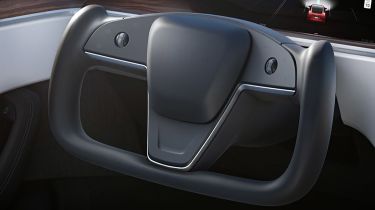Tesla Model S hatchback - Electric motor, drive & performance
The Model S is blisteringly fast, but rivals are more fun to drive
Because the Tesla Model S is powered by an electric motor, it rockets away from a standing start – and with no gearshifts, it's incredibly smooth to drive. It's also eerily quiet, emitting just a low whir accompanied by road and wind noise.
Although 19-inch alloy wheels are standard, 21-inch alloy wheels are a popular option for the Model S, even though they're expensive. An early 2019 update saw the introduction of the new fully adaptive damping for the air suspension system, which automatically senses the road conditions and driver's inputs. This means it can soften to help soak up bumps and sharpen up when tackling a windy road.
The floor-mounted battery pack gives the two-tonne Model S a much lower centre of gravity than a conventional car, giving it an advantage over petrol-powered rivals. It grips securely, particularly thanks to its dual-motor, four-wheel-drive setup, and corners with barely any body lean, with its traction-control system working hard to deploy all that power effectively. However, while the steering feels weighty, it doesn’t provide much feedback. The Model S also struggles to shed its two-tonne bulk on a twisty road – a Porsche Taycan or Audi e-tron GT will provide a much more rewarding experience for keen drivers.
More reviews
In-depth reviews
Like most electric cars, the Model S features a regenerative braking system, which harnesses the energy created during braking and sends it back to the battery to improve your driving range. This allows you to effectively drive the car with only one pedal, with it slowing down whenever you take your foot off the accelerator. While this is unnerving at first, it’s very easy to become accustomed to. Fortunately, you can also adjust the amount of regenerative braking provided – less makes the car better to drive, while more increases the amount of charge put back into the battery.
Tesla Model S electric motor
If you’ve never driven an electric car, you may be surprised by the instant response you get when you press the accelerator pedal. The Tesla Model S takes this blistering acceleration to another level; as you move up the range, the Tesla Model S grows progressively faster, however, even the base car is supercar-quick.
Simply named the ‘Model S’, the base car utilises a powerful dual-electric motor setup to propel the two-tonne saloon from 0-60mph in just 3.1 seconds – faster than even a Ferrari Roma. If that’s not quick enough, take a look at the range-topping 1,006bhp Plaid model; this can reach the 60mph benchmark in just 1.99 seconds, making it the fastest-accelerating production car in the world.
Even in the standard version, we were amazed by the Tesla’s acceleration when passing slower traffic – surging from 45-65mph is claimed to take just over a second and we have no reason to doubt it. The near-silence of the electric motors is calming if you can resist the temptation to accelerate at warp speed, while the power delivery is consistently smooth.









